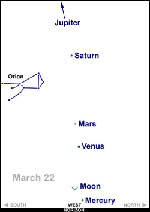
Image credit: NASA/JPL
Like a busy urban family, planets rarely get together all at once. Later this month, however, the five so-called naked-eye planets – Mercury, Venus, Mars, Jupiter and Saturn – will reunite in the night sky, giving spectators a unique chance to see Earth’s closest companions in one easy sitting.
The gathering will be visible every night for an hour after sunset, beginning around March 22 and lasting about two weeks. While other opportunities to catch a five-planet rendezvous will take place in the next few years, both at dawn and dusk, this one is not to be missed.
“This particular planetary grouping will quite possibly offer the best nighttime views until 2036,” says Dr. Myles Standish, an astronomer at NASA’s Jet Propulsion Laboratory, Pasadena, Calif.
For early risers, there will be another chance to see all five naked-eye planets together just before sunrise in December of this year and early January 2005.
Since ancient times, the naked-eye planets have intrigued and inspired onlookers all over the world. But only sporadically, usually every few years or so, do their orbits take them to the same side of the Sun. When this happens, the planets stretch across the morning or evening skies depending on which side of the Sun they reside. More rare are planetary alignments in which the five planets assemble in a very small corner of the sky.
“Every so often the five visible planets will collect on one side of the Sun,” says Standish. “Only when conditions are right, will they all be clearly visible at either dusk or dawn.”
The Details
To catch the planetary get-together, you’ll need a good view of the sky, free of buildings and bright city lights (you should still be able to see the planets through urban light pollution). The show begins around March 22 and lasts through early April, when Mercury fades from sight. The finest views will take place during the last 8 to 10 days of March.
Begin by looking to the western horizon each evening just after sunset. Seated in a row up and across the sky will be Mercury, Venus, Mars and Saturn. Saturn will lie almost directly overhead. Following the line of the planets, Jupiter will be close to the eastern horizon. Together, the planets will span about 135 degrees. About an hour after dusk, Mercury will dip below the western horizon.
The Moon will also be attending the festivities, mingling through the planets in an orderly fashion. On March 22, it will take a seat next to Mercury, and then climbing up the night sky, it will end its tour on April 1 right above mighty Jupiter, the largest planet in our solar system. As the Moon slides from planet to planet, it will grow in size from a slender crescent to a nearly full circle of white.
Note that Venus is currently brighter than usual because of where it lies in relation to Earth and the Sun.
The Moon and planets will appear to follow nearly the same path through the stars. This is because their orbits around the Sun occupy planes that are close to that of Earth’s orbit. The plane Earth moves in is called the ecliptic.
If for some reason you miss the “Fab Five,” another set of orbiting bodies will soon make a grand debut. In April and May of this year, two naked-eye comets, C/2001 Q4 and C/2002 T7, will grace the twilight skies. To spot the cosmic balls of dust and ice look to the west at dusk or dawn. A pair of binoculars will help to initially locate the comets because they may be slightly washed out by the Sun. On May 12 to 16 look out for a mini-reunion with the naked-eye planets, when comet C/2001 Q4 lines up with Venus, Mars, Saturn and Jupiter.
Original Source: NASA/JPL News Release
